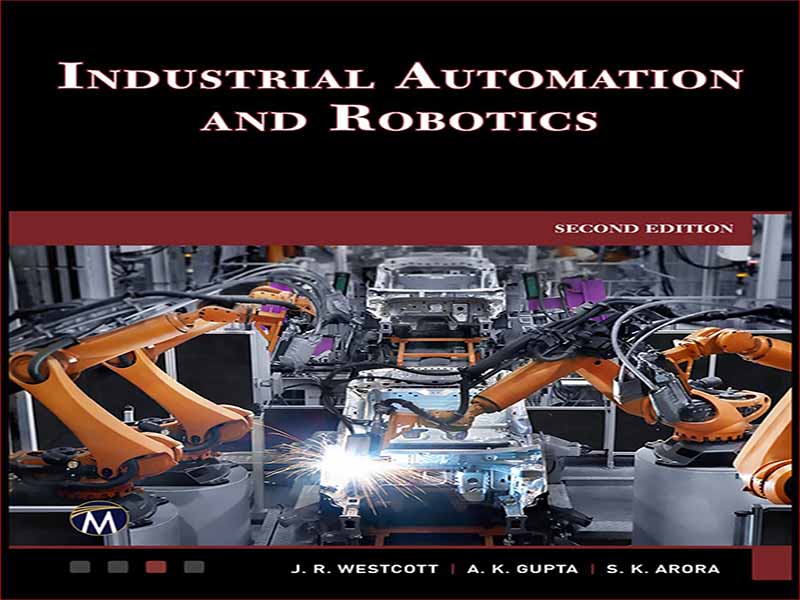- عنوان کتاب: Industrial Automation and Robotics
- نویسنده: Jean Riescher Westcott
- حوزه: رباتیک, اتوماسیون صنعتی
- سال انتشار: 2024
- تعداد صفحه: 643
- زبان اصلی: انگلیسی
- نوع فایل: pdf
- حجم فایل: 19.8 مگابایت
کلمه اتوماسیون از کلمه یونانی “automatos” به معنای خود کنش گرفته شده است. کلمه اتوماسیون در اواسط دهه 1940 توسط صنعت خودروسازی ایالات متحده برای نشان دادن جابجایی خودکار قطعات بین ماشینهای تولیدی، همراه با پردازش مداوم آنها در ماشینها ابداع شد. پیشرفت در رایانه ها و سیستم های کنترل، تعریف اتوماسیون را گسترش داده است. در اواسط قرن بیستم، اتوماسیون سالها در مقیاس کوچک وجود داشت و از دستگاههای مکانیکی برای خودکارسازی تولید اقلام ساده استفاده میکرد. با این حال، این مفهوم تنها با افزودن کامپیوتر، که انعطافپذیری آن به آن اجازه میدهد تقریباً هر نوع کاری را انجام دهد، واقعاً عملی شد. اتوماسیون را می توان به طور کلی به عنوان فرآیند دنبال کردن یک توالی از پیش تعیین شده از عملیات با نیروی انسانی کم یا بدون نیروی انسانی، با استفاده از تجهیزات و دستگاه های تخصصی که فرآیندهای تولید را انجام و کنترل می کنند، تعریف کرد. اتوماسیون به معنای کامل آن از طریق استفاده از انواع دستگاهها، حسگرها، محرکها، تکنیکها و تجهیزاتی به دست میآید که قادر به مشاهده فرآیند ساخت، تصمیمگیری در مورد تغییراتی که باید در عملیات ایجاد شود، و کنترل میشوند. تمام جنبه های آن اتوماسیون فرآیندی در صنعت است که در آن عملیات مختلف تولید از یک فرآیند دستی به یک فرآیند خودکار یا مکانیزه تبدیل می شود. مثال: فرض کنید یک کارگر در حال کار با ماشین تراش فلزی است. کارگر سهام را که قبلاً به اندازه بریده شده است، از یک سطل جمع آوری می کند. سپس آن را در چاک تراش قرار می دهد و چرخ های دستی مختلف را روی دستگاه حرکت می دهد تا یک جزء ایجاد شود. یک پیچ می تواند چنین موردی باشد. هنگامی که کار تمام شد، کارگر دوباره فرآیند را برای ساختن یک مورد دیگر آغاز می کند. این یک فرآیند دستی خواهد بود. اگر این فرآیند خودکار بود، کارگر میله های طولانی را در مکانیزم تغذیه ماشین تراش اتوماتیک قرار می داد. مکانیسمهای تراش، مواد را به چاک میرسانند، قطعه را به شکل و اندازه درست میچرخانند و قبل از شروع یک مورد دیگر، میله را جدا میکنند. این نمونه ای از یک ماشین خودکار در یک فرآیند تولید است. اتوماسیون گامی فراتر از مکانیزاسیون است، که در آن اپراتورهای انسانی ماشین آلاتی برای کمک به آنها در کارشان فراهم می کنند. گفته می شود که رباتیک صنعتی قابل مشاهده ترین بخش اتوماسیون است. فرآیندهای خودکار مدرن عمدتاً توسط برنامه های رایانه ای کنترل می شوند که از طریق عملکرد حسگرها و محرک ها، پیشرفت را رصد کرده و توالی رویدادها را تا تکمیل فرآیند کنترل می کنند. تصمیمات اتخاذ شده توسط رایانه تضمین می کند که فرآیند به طور دقیق و سریع تکمیل می شود.
The word automation comes from the Greek word “automatos,” meaning self-acting. The word automation was coined in the mid-1940s by the U.S. automobile industry to indicate the automatic handling of parts between production machines, together with their continuous processing at the machines. The advances in computers and control systems have extended the definition of automation. By the middle of the 20th century, automation had existed for many years on a small scale, using mechanical devices to automate the production of simply shaped items. However the concept only became truly practical with the addition of the computer, whose flexibility allowed it to drive almost any sort of task. Automation can generally be defined as the process of following a predetermined sequence of operations with little or no human labor, using specialized equipment and devices that perform and control manufacturing processes. Automation in its full sense, is achieved through the use of a variety of devices, sensors, actuators, techniques, and equipment that are capable of observing the manufacturing process, making decisions concerning the changes that need to be made in the operation, and controlling all aspects of it. Automation is the process in industry where various production operations are converted from a manual process, to an automated or mechanized process. Example: Let’s assume that a worker is operating a metal lathe. The worker collects the stock, already cut to size, from a bin. He then places it in the lathe chuck, and moves the various hand-wheels on the machine to create a component; a bolt could be such an item. When finished the worker begins the process again to make another item. This would be a manual process. If this process were automated, the worker would place long lengths of bar into the feed mechanism of an automatic lathe. The lathe mechanisms feed the material into the chuck, turn the piece to the correct shape and size, and cut it off the bar before beginning another item. This is an example of an automated machine in a manufacturing process. Automation is a step beyond mechanization, where human operators are provided with machinery to help them in their jobs. Industrial robotics are said to be the most visible part of automation. Modern automated processes are mostly controlled by computer programs, which through the action of sensors and actuators, monitor progress and control the sequences of events until the process is complete. Decisions made by the computer ensure that the process is completed accurately and quickly.
این کتاب را میتوانید بصورت رایگان از لینک زیر دانلود نمایید.
Download: Industrial Automation and Robotics
































نظرات کاربران